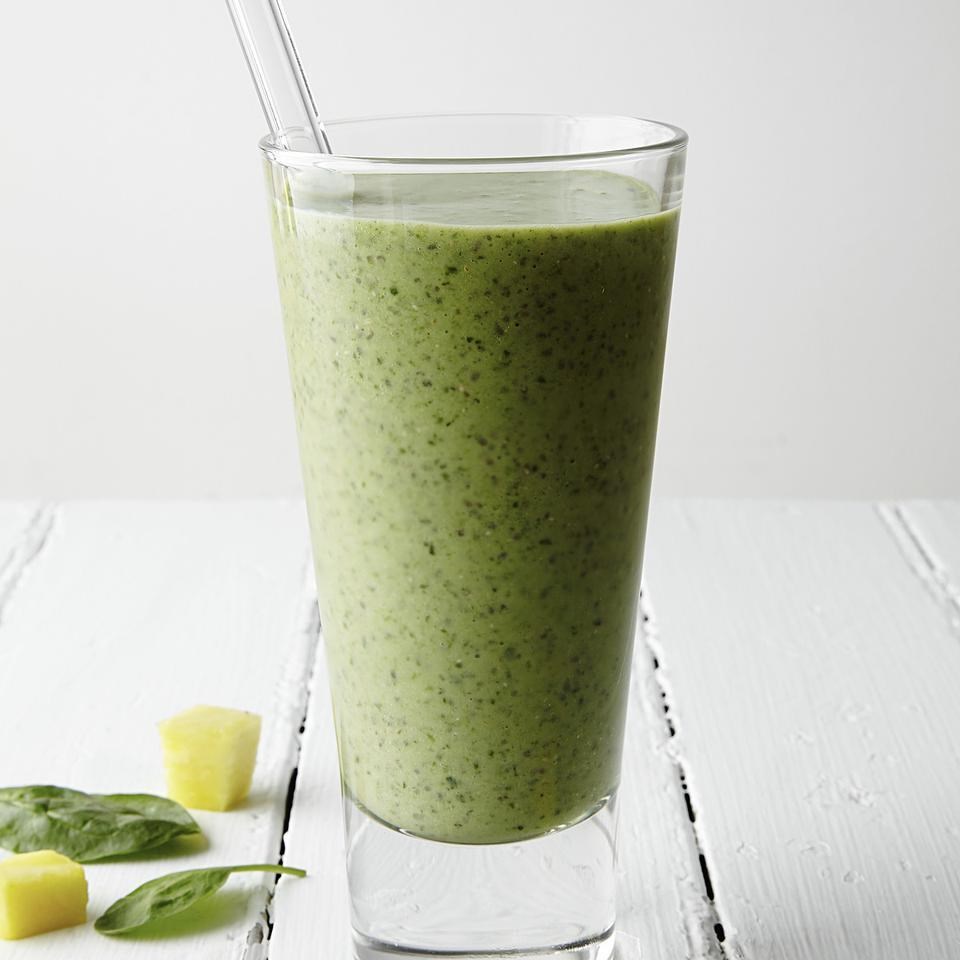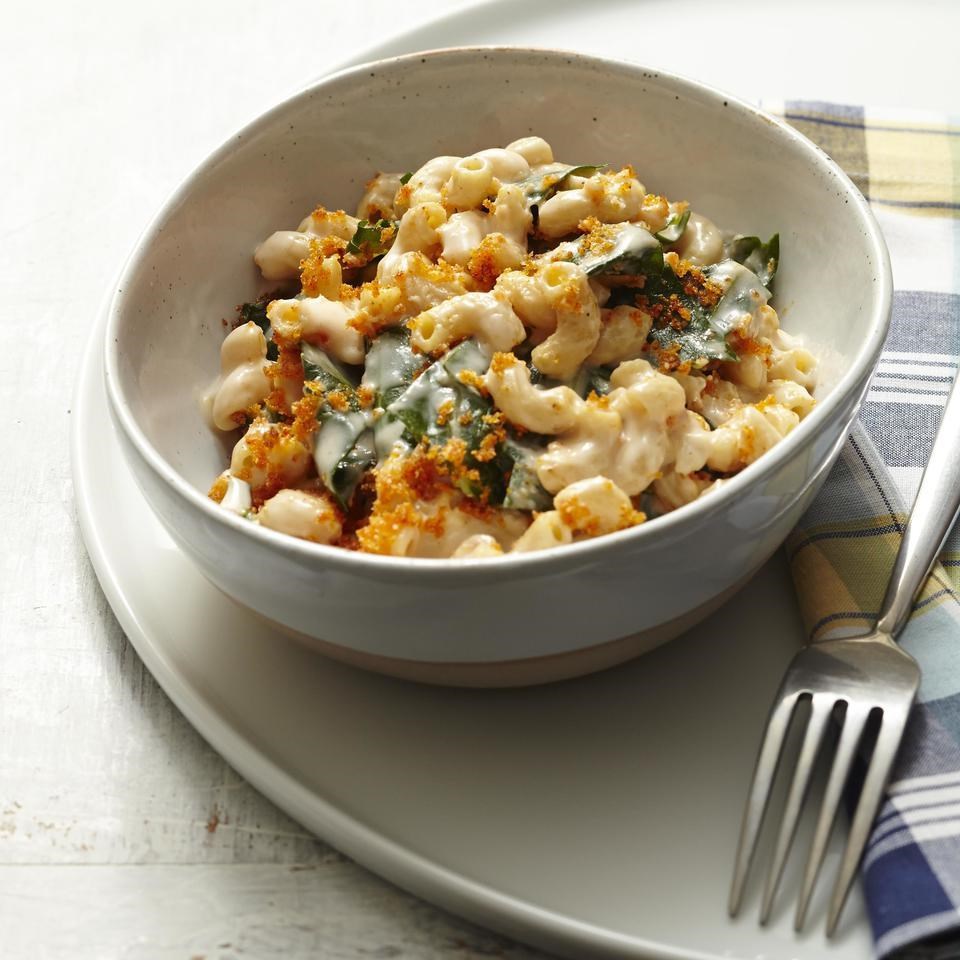Eating clean is a lot easier when your cupboards, fridge and freezer are filled with healthy, clean foods. When you're eating clean, whole foods like fruits and vegetables are obvious choices. Minimally processed foods with short ingredient lists can also fit into a clean-eating diet. Choose foods with healthy ingredients like whole grains and healthy fats and those low in added sugar and salt. From the produce aisle to the meat counter from desserts to drinks you may be wondering which foods to actually eat when you're eating clean. Here are some tips to help you stock your kitchen with foods that make it easier to eat clean.
Fruit

Pictured Recipe: Pineapple Green Smoothie
Fruit is almost always a clean choice. Some people worry about fruit's sugar content but fruit is packed with vitamins, minerals and fiber. Health experts don't worry about natural sugars for the most part because it's hard to overdo it and you're getting beneficial nutrients. You will want to check labels for added sugars in canned fruits and dried fruits.
Fruit is almost always a clean choice. Some people worry about fruit's sugar content but fruit is packed with vitamins, minerals and fiber. Health experts don't worry about natural sugars for the most part because it's hard to overdo it and you're getting beneficial nutrients. You will want to check labels for added sugars in canned fruits and dried fruits.
Fruit juice can count toward your daily recommended fruit intake, too—just make sure it's 100% juice. Even 100% fruit juices don't contain the beneficial fiber found in whole fruits, so you may want to limit your intake.
Related: Healthy Fruit Smoothie Recipes
Clean Fruit to Choose:
• Fresh fruit
• Canned fruit with no added sugar
• Frozen fruit with no added sugar
• Dried fruit with no added sugar
• 100% fruit juice
• Canned fruit with no added sugar
• Frozen fruit with no added sugar
• Dried fruit with no added sugar
• 100% fruit juice
Vegetables

Pictured Recipe: Green Shakshuka
Vegetables should be the building blocks of your clean-eating meals because they're packed with vitamins, minerals and fiber. Frozen and canned vegetables are healthy, too, but choose ones without sauces and be sure to read the label since even items that look plain may have added salt. There are tons of convenient ways to eat your veggies, when you're short on prep-time. Supermarkets offer a variety of pre-cut vegetables and even pre-spiralized veggie noodles (plus, there's always frozen). We're all for shortcuts that make it easier to get vegetables into your diet, but watch out for veggie chips and veggie pasta that may just have a sprinkling of vegetable dust, rather than a full serving of vegetables.
Don't Miss: Take Our Eat More Vegetables Challenge
Clean Vegetables:
• Any fresh vegetable
• Frozen vegetables with no sauce or added salt
• Canned vegetables with no sauce or added salt
• Frozen vegetables with no sauce or added salt
• Canned vegetables with no sauce or added salt
Whole Grains

Pictured Recipe: Quinoa Avocado Salad
Whole grains are the healthy, good-for-you carbs that deliver fiber and nutrition. Whole grains, such as brown rice, quinoa, barley, oats, farro or millet, are relatively unprocessed and contain only one ingredient. They're about as clean as you can get. When it comes to other whole-grain products, look for whole-wheat versions of pasta, refrigerated pizza dough, bread and English muffins (just be sure that whole-wheat flour is the first ingredient and there isn't sugar in the ingredient list). Even popcorn is a whole grain: buy the kernels and pop them on the stove or in an air popper for a clean snack that doesn't have the additives and buttery calories you find in microwave bags.
Clean Whole Grains:
• Single-ingredient grains, such as farro, millet, oats, barley, quinoa, brown rice, etc.
• Whole-wheat pasta
• Popcorn
• Sprouted whole-grain bread and English muffins (with no added sugar)
• Whole-wheat pizza dough
• Whole-wheat pasta
• Popcorn
• Sprouted whole-grain bread and English muffins (with no added sugar)
• Whole-wheat pizza dough
Dairy

Pictured Recipe: Mac & Cheese with Collards
Choose plain yogurt (either regular or Greek) over vanilla and fruit-flavored yogurts, which are high in added sugar, to clean up your diet. Dairy products, such as cheese and milk, can do double duty: eat them solo or use them as ingredients in cleaner homemade versions of foods, such as pizza and macaroni and cheese. Opting for nondairy alternatives, such as soy, coconut and almond milk? Look for unsweetened varieties to avoid added sugar. Also, check reduced- and low-fat dairy products to make sure they aren't loaded with fillers or weird ingredients (some are, some aren't). Plain, whole-milk dairy is a clean choice.
Choose plain yogurt (either regular or Greek) over vanilla and fruit-flavored yogurts, which are high in added sugar, to clean up your diet. Dairy products, such as cheese and milk, can do double duty: eat them solo or use them as ingredients in cleaner homemade versions of foods, such as pizza and macaroni and cheese. Opting for nondairy alternatives, such as soy, coconut and almond milk? Look for unsweetened varieties to avoid added sugar. Also, check reduced- and low-fat dairy products to make sure they aren't loaded with fillers or weird ingredients (some are, some aren't). Plain, whole-milk dairy is a clean choice.
Clean Dairy Foods:
• Plain yogurt
• Milk
• Cheese
• Unsweetened nondairy milks
• Milk
• Cheese
• Unsweetened nondairy milks
Protein

Pictured Recipe: Pork Chops with Creamy Mushroom Sauce
Meat offers protein, iron and vitamin B12. Eating cleaner means avoiding processed foods, so steer clear of bologna, salami, pepperoni and hot dogs. These—and other processed meat products—are usually high in sodium and may contain artificial colors as well as preservatives. Choosing environmentally-sustainable protein when possible can help you with clean-eating, too. We created clean-eating guides for chicken, pork and beef to help you discern what the labels mean.
Meat offers protein, iron and vitamin B12. Eating cleaner means avoiding processed foods, so steer clear of bologna, salami, pepperoni and hot dogs. These—and other processed meat products—are usually high in sodium and may contain artificial colors as well as preservatives. Choosing environmentally-sustainable protein when possible can help you with clean-eating, too. We created clean-eating guides for chicken, pork and beef to help you discern what the labels mean.
Fish and shellfish can be super-healthy protein sources and many fish contain heart-healthy omega-3 fats. Choose sustainably sourced seafood when possible. Check out our clean-eating buyer's guide to seafood to help you make smart choices.
Eggs are a great choice—and don't skip the yolk or you'll miss out on extra protein and nutrients.
Nuts, seeds and beans are all great choices for plant-based proteins. Just be sure to look for lower-sodium options when possible.
Clean Proteins:
• Single-ingredient meats: chicken breast, chicken legs, ground beef, etc.
• Seafood (choose sustainable options, such as wild salmon and Pacific cod)
• Eggs
• Unflavored nuts (e.g., almonds, cashews, hazelnuts, walnuts)
• Plain nut butters (no added sugar)
• Dried beans
• Canned beans (rinse to reduce sodium by 35%)
• Seafood (choose sustainable options, such as wild salmon and Pacific cod)
• Eggs
• Unflavored nuts (e.g., almonds, cashews, hazelnuts, walnuts)
• Plain nut butters (no added sugar)
• Dried beans
• Canned beans (rinse to reduce sodium by 35%)
Desserts

Pictured Recipe: Apple "Donuts"
How "clean" your diet is, is up to you. You may cut added sugar out entirely, or limit it. Most traditional desserts from a package don't fit the bill when you're eating clean. They are typically made with refined flours and lots of added sugars. However, you don't have to ban sweets from your life. You can make treats at home with less sugar, fruit and whole grains or go totally-added sugar free with some fruit-based treats.
Drinks
Drinks can be big source of added sugar. Steer clear of sodas, sweetened teas and specialty flavored-coffee drinks. Unsweetened tea and coffee, water and seltzer are all clean choices. Add a splash of juice to seltzer and serve it in a special glass to make your drink a little more special. Also, alcohol may be something you want to cut out if you're eating clean, but you don't have to. You do need to limit—it's recommended women have no more than 1 drink a day, and men no more than 2. Wine and beer are appropriate but if you prefer cocktails watch out for sugary mixers with lots of sugar.







0 comments:
Post a Comment
I'd love to hear your comments, do share your thoughts with me...